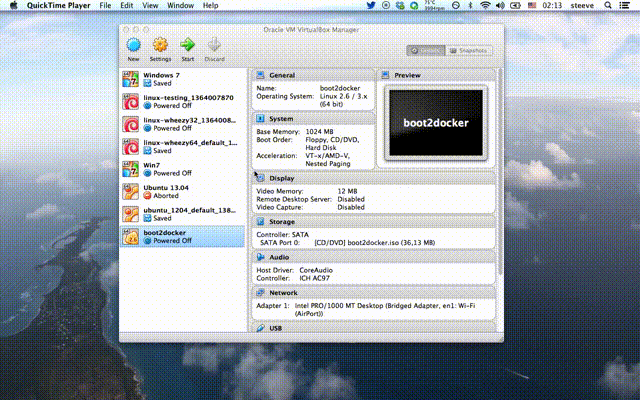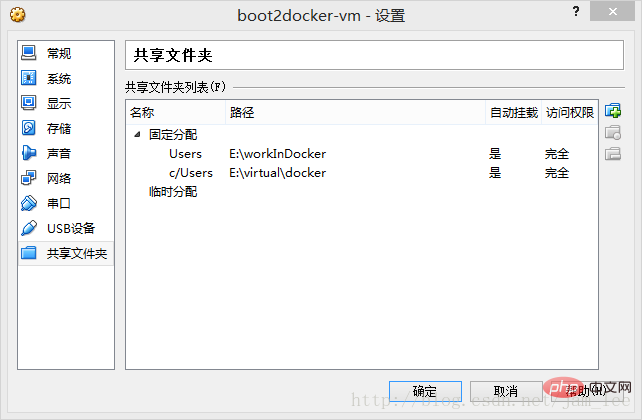What system is boot2docker?
Boot2Docker is a lightweight Linux distribution designed specifically for Docker. It is an operating system used to solve the problem that Windows or OS X users cannot install Docker. Boot2Docker runs completely in memory, is 24M in size, and only takes 5-6 seconds to start.

The operating environment of this tutorial: linux5.9.8 system, docker-1.13.1 version, Dell G3 computer.
Boot2Docker is a lightweight Linux distribution based on Tiny Core Linux. It is an operating system that solves the problem that Windows or OS X users cannot install Docker. Boot2Docker is specially prepared for Docker, runs completely in memory, is 24M in size, and only takes 5-6 seconds to start.
Boot2Docker needs to run in VirtualBox. For specific installation, please refer to the official documentation (https://github.com/boot2docker/boot2docker#installation).

Step one: Download bootdocker2.exe and install it
https://github.com/boot2docker/windows- installer/releases
After the installation is complete, there will be a startup script on the desktop. Opening it will start the virtual machine vbox and run the boot2docker inside. Here
Note: This system is only a readable system, and changes to the system will not be retained. For example, if I execute: mkdir, work, and then restart, I will not see the wrok folder, but all the docker images and operations will be retained. On the virtual hard disk, it will not be lost.
Step 2: Mount the shared folder
This system has a default mounting mechanism
Share name: c/User will be mounted to /c/Users

Look at the picture: In this way, I map /c/Users in the virtual machine to E:\virual\docker (its share name is c/Users)
There are some more below:
Users Mount to /Users
/Users Mount to /Users
c/Users Mount to /c/Users
/c/Users Mount to /c/Users
c:/Users Mount to /c/Users
In this way, the windows directory is mounted to boot2docker. The next step is docker.
Recommended learning: "docker video tutorial"
The above is the detailed content of What system is boot2docker?. For more information, please follow other related articles on the PHP Chinese website!

Hot AI Tools

Undresser.AI Undress
AI-powered app for creating realistic nude photos

AI Clothes Remover
Online AI tool for removing clothes from photos.

Undress AI Tool
Undress images for free

Clothoff.io
AI clothes remover

Video Face Swap
Swap faces in any video effortlessly with our completely free AI face swap tool!

Hot Article

Hot Tools

Notepad++7.3.1
Easy-to-use and free code editor

SublimeText3 Chinese version
Chinese version, very easy to use

Zend Studio 13.0.1
Powerful PHP integrated development environment

Dreamweaver CS6
Visual web development tools

SublimeText3 Mac version
God-level code editing software (SublimeText3)

Hot Topics
 How to exit the container by docker
Apr 15, 2025 pm 12:15 PM
How to exit the container by docker
Apr 15, 2025 pm 12:15 PM
Four ways to exit Docker container: Use Ctrl D in the container terminal Enter exit command in the container terminal Use docker stop <container_name> Command Use docker kill <container_name> command in the host terminal (force exit)
 How to copy files in docker to outside
Apr 15, 2025 pm 12:12 PM
How to copy files in docker to outside
Apr 15, 2025 pm 12:12 PM
Methods for copying files to external hosts in Docker: Use the docker cp command: Execute docker cp [Options] <Container Path> <Host Path>. Using data volumes: Create a directory on the host, and use the -v parameter to mount the directory into the container when creating the container to achieve bidirectional file synchronization.
 How to restart docker
Apr 15, 2025 pm 12:06 PM
How to restart docker
Apr 15, 2025 pm 12:06 PM
How to restart the Docker container: get the container ID (docker ps); stop the container (docker stop <container_id>); start the container (docker start <container_id>); verify that the restart is successful (docker ps). Other methods: Docker Compose (docker-compose restart) or Docker API (see Docker documentation).
 How to check the name of the docker container
Apr 15, 2025 pm 12:21 PM
How to check the name of the docker container
Apr 15, 2025 pm 12:21 PM
You can query the Docker container name by following the steps: List all containers (docker ps). Filter the container list (using the grep command). Gets the container name (located in the "NAMES" column).
 How to start containers by docker
Apr 15, 2025 pm 12:27 PM
How to start containers by docker
Apr 15, 2025 pm 12:27 PM
Docker container startup steps: Pull the container image: Run "docker pull [mirror name]". Create a container: Use "docker create [options] [mirror name] [commands and parameters]". Start the container: Execute "docker start [Container name or ID]". Check container status: Verify that the container is running with "docker ps".
 How to start mysql by docker
Apr 15, 2025 pm 12:09 PM
How to start mysql by docker
Apr 15, 2025 pm 12:09 PM
The process of starting MySQL in Docker consists of the following steps: Pull the MySQL image to create and start the container, set the root user password, and map the port verification connection Create the database and the user grants all permissions to the database
 How to update the image of docker
Apr 15, 2025 pm 12:03 PM
How to update the image of docker
Apr 15, 2025 pm 12:03 PM
The steps to update a Docker image are as follows: Pull the latest image tag New image Delete the old image for a specific tag (optional) Restart the container (if needed)
 How to create containers for docker
Apr 15, 2025 pm 12:18 PM
How to create containers for docker
Apr 15, 2025 pm 12:18 PM
Create a container in Docker: 1. Pull the image: docker pull [mirror name] 2. Create a container: docker run [Options] [mirror name] [Command] 3. Start the container: docker start [Container name]






